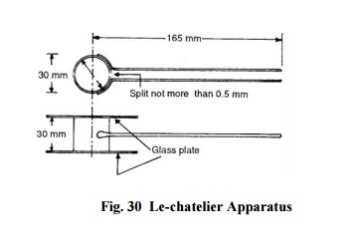Theory: The ability of cement to maintain a constant volume is known as soundness of the cement. It is essential that the cement concrete shall not undergo appreciable change in volume after setting.
Unsoundness produces cracks, distortion and disintegration there by giving passage to water and atmospheric gases which may have injurious effects on concrete and reinforcement.
Soundness of cement is ensured by limiting the quantities of free lime, magnesia and sulphates as these compounds undergo a large change in volume. Unsoundness in cement does not come to surface for a considerable period of time.
Thus this test is designed to accelerate the hydration of free lime by the application of heat thus discovering the defects in a short time. Further, to minimize the shrinkage of cement paste, the test setup is kept immersed in water bath.
This test is carried out with the help of “Le Chatelier’s apparatus” which consists of a small split cylinder of spring brass or other suitable metal of 0.5mm thickness forming a mould 30 mm internal diameter and 30mm high on either side of the split mould are attached to indicators with pointed ends, the distance from these ends to the centre of the cylinder being 165 mm. The mould shall be kept in good condition with the jaws not more than 50mm apart.
Objective: Determination of soundness of cement by Le-Chatelier method.
Reference: IS 4031 (Part-3):1988.
Apparatus: Le- Chatelier apparatus conforming to IS: 5514-1969; Measuring cylinder; Gauging trowel; Balance; Water bath.
Material: Ordinary Portland cement; Water; Grease
Procedure:
- Weigh accurately 100 g of cement to the nearest 0.15 g and add to it 0.78 times the water required to give a paste of standard consistency (i.e. 0.78×P).
- Place the lightly grease mould on a lightly grease glass sheet and fill it with cement paste, taking care to keep the edges of the mould gently together.
- Cover the mould with another piece of lightly grease glass sheet, place a small weight on this covering glass sheet and immediately submerge the whole assembly in water at a temperature of 27 ± 20 𝐶𝐶.
- Keep this assembly under water for 24 hrs. After this, take the mould out of water and measure the distance between two indicators. Submerge the mould again in the water.
- Bring the water to boiling with the mould kept submerged, and keep it boiling for 25 to 30 minutes.
- Remove the mould from the water allow it to cool and measure the distance between the indicator points.
- The difference between these two measurements represents the expansion of the cement.
- Repeat the whole procedures two more times each using fresh 100 g sample.
Observations:
Samples:
Distance between pointers before boiling (D1) in mm
Distance between pointers after boiling (D2) in mm
Expansion of the cement = E1 = (D2- D1) in mm
Average expansion of the cement in mm
Result: Average expansion of the cement is obtained is ___________ mm.
Conclusions: Average expansion of the cement as per Le- Chatelier test is less than/ more than 10 mm. therefore the given sample of cement is found to be sound/ unsound as per IS code
